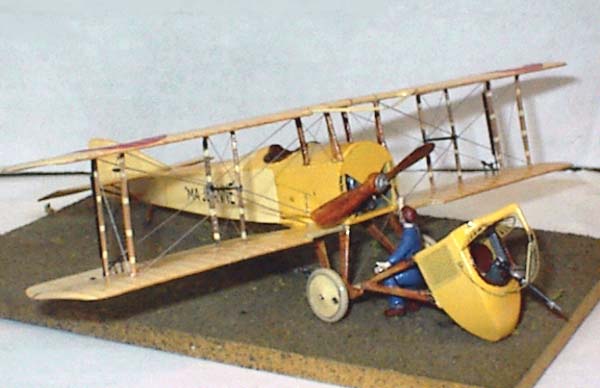 SPIN
1/48 Resin SPAD A.2
SPIN
1/48 Resin SPAD A.2
by Steve Perry
Introduction
The Spad A.2 and later the A.4 were known as pulpit fighters. They were however, not designed as fighters but as observation machines. The precarious perch out front of the spinning prop was put there for the view rather than the field of fire. A Lewis gun was an afterthought as defense was added to the observer's duties. The pulpit must have been an extremely cold office from which to conduct business, similar to pushers of the day.
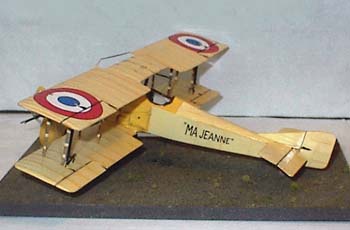 Not
produced in great quantities, or used extensively, it seems the propensity
to nose over on landing and pureé or flatten the observer was a
bigger negative than the view was a positive. The Americans serving in
N.124 had occasion to look one over when it landed at their field. All
indicated an unwillingness to fly in the machine. The Russians operated
more of these machines than the French including the A.4 model. They were
fitted with skis for winter operation. The Spad A.2 soon faded from the
front and the stellar performance of their VII and XII models more than
made up for the lackluster reputation of the pulpit fighters, although
they used the same aileron control mechanism and modified single bay wing
cellule that became Spad trademarks.
Not
produced in great quantities, or used extensively, it seems the propensity
to nose over on landing and pureé or flatten the observer was a
bigger negative than the view was a positive. The Americans serving in
N.124 had occasion to look one over when it landed at their field. All
indicated an unwillingness to fly in the machine. The Russians operated
more of these machines than the French including the A.4 model. They were
fitted with skis for winter operation. The Spad A.2 soon faded from the
front and the stellar performance of their VII and XII models more than
made up for the lackluster reputation of the pulpit fighters, although
they used the same aileron control mechanism and modified single bay wing
cellule that became Spad trademarks.
The Kit
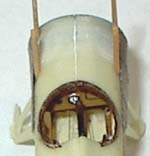 The
Spin resin kit is one of the nicest resin kits I have ever seen. The thinness
of the wings and tailplanes is very much to scale and looks great. There
is a fret of PE brass, my example was nice, but had a bit of discoloration
from the manufacturing process. The smaller resin parts come in wafers
and are easy to clean up. There is some cockpit detail and those who enjoy
such pursuits will find it a good basis for super detailing. Those of
us less ambitious will still get a decent interior straight out of the
box or with just a detail or two added.
The
Spin resin kit is one of the nicest resin kits I have ever seen. The thinness
of the wings and tailplanes is very much to scale and looks great. There
is a fret of PE brass, my example was nice, but had a bit of discoloration
from the manufacturing process. The smaller resin parts come in wafers
and are easy to clean up. There is some cockpit detail and those who enjoy
such pursuits will find it a good basis for super detailing. Those of
us less ambitious will still get a decent interior straight out of the
box or with just a detail or two added.
I basically followed the general construction sequence indicated on the plans. The interior was OOB except for control cables from the rudder bar and joystick plus some instruments. The fuselage went together well, but there was some sanding and filling to do on the central seam.
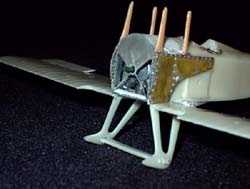 The
mounting of the lower wing to the LG strut is not readily apparent at
first glance, so look well at the sketch on the plans and follow all the
snake-like arrows showing where parts go on the exploded view. Once the
lower wing is mounted on the LG the model goes together pretty fast..
Just be sure to take your time and get those lower wing panels true with
the fuselage.
The
mounting of the lower wing to the LG strut is not readily apparent at
first glance, so look well at the sketch on the plans and follow all the
snake-like arrows showing where parts go on the exploded view. Once the
lower wing is mounted on the LG the model goes together pretty fast..
Just be sure to take your time and get those lower wing panels true with
the fuselage.
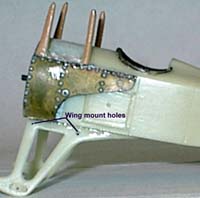 Roll
a slight curve into the brass cowl cheek pieces and you will have no trouble
sticking them on the fuselage sides. The cabines fit in this assembly
too. Get them right and you will greatly ease the top wing alignment job.
Roll
a slight curve into the brass cowl cheek pieces and you will have no trouble
sticking them on the fuselage sides. The cabines fit in this assembly
too. Get them right and you will greatly ease the top wing alignment job.
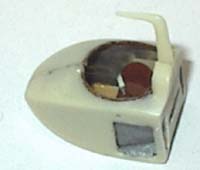 The
pulpit goes together well and is like a second smaller fuselage. I used
Testors clear window film for the observer's window in the floor of the
pulpit. I also chose to display my model with the pulpit lowered down
and a mechanic servicing the engine. I think this emphasizes both the
odd location of the prop and the precariousness of the observer's perch.
The
pulpit goes together well and is like a second smaller fuselage. I used
Testors clear window film for the observer's window in the floor of the
pulpit. I also chose to display my model with the pulpit lowered down
and a mechanic servicing the engine. I think this emphasizes both the
odd location of the prop and the precariousness of the observer's perch.
Painting
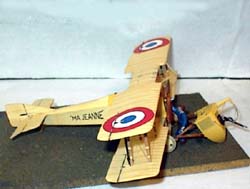
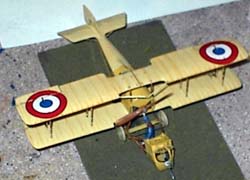 I
painted the model with Liquitex thinned with Future. The decals went down
well, but the tail numbers disintegrated. I would recommend a coat of
clear decal film before you use them. I rigged the plane with stretched
sprue. The mechanic was from a WWII bomber kit. I carved his WWII uniform
to a coverall.
I
painted the model with Liquitex thinned with Future. The decals went down
well, but the tail numbers disintegrated. I would recommend a coat of
clear decal film before you use them. I rigged the plane with stretched
sprue. The mechanic was from a WWII bomber kit. I carved his WWII uniform
to a coverall.
Conclusion
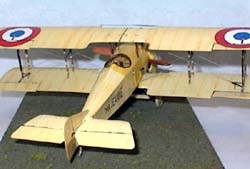 The
Spin kit is a fine build and I recommend it to anyone wanting a model
of this unusual aircraft. I will look forward to building other kits in
Spin's line.
The
Spin kit is a fine build and I recommend it to anyone wanting a model
of this unusual aircraft. I will look forward to building other kits in
Spin's line.
Thanks to Lubos Vinar of VAMP Mail Order for the kit.




